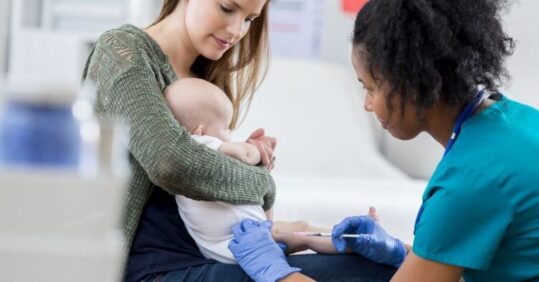Mythbuster: ‘All these jabs are overloading children’s immune systems’

In the latest in our series exploring misconceptions in health, GP Dr Toni Hazell dispels the pervasive myth that today’s routine childhood vaccinations are ‘overloading’ children’s immune systems
Vaccines are a good thing. There’s no doubting that statement. Approximately 20 million cases of measles (and 4,500 deaths) have been prevented by vaccination,1 and 29 million people have been prevented from being paralysed,2 because vaccination stopped them from getting polio. Vaccines can even prevent cancer: it’s expected that those who get the HPV vaccine at the age of 12-13 will have an 87% reduction in cervical cancer diagnoses,3 compared to their unvaccinated peers.
So why is vaccine uptake falling so much? The WHO have put vaccine hesitancy in their list of top 10 threats to global health and vaccine coverage in the UK is currently on a downward trend,4,5 with no vaccines meeting the 95% target which is ideal for herd immunity.
The reasons for this are complex and include an increased reliance on social media;6 it is also possible that we are a victim of our own success – if parents never see the damage that measles or whooping cough can cause, because they are less common (due to vaccination), maybe they won’t see the need to get their child vaccinated.
One key contributing factor – a concern that is cited by vaccine hesitant parents,7 and which has become a common trope of the anti-vax movement – is that there are too many vaccinations these days and that we overload our children’s immune systems.8,9
Related Article: Diagnosis Connect service will link people to advice from charities
The reality
It is simply not true that vaccinations will overload a child’s immune system. Babies and children come into contact with a huge number of infectious diseases every day – we all know how many coughs and colds a child gets when they start nursery, and every parent of an infant knows that they put their hands, fresh from crawling on the floor, straight into their mouths, possibly along with something interesting that they have found on the floor to chew on to alleviate their teething pain. When compared to all these things which stimulate the immune system, the addition of a few vaccinations given on the same day is a tiny effect. It is estimated that the human body has enough white cells to cope with thousands of vaccines at any one time,10 and that 11 vaccines given together would use up about one-thousandth of the capacity of the immune system.
A related part of this concern about vaccine overload is that vaccination weakens the immune system, compared to letting the child just meet the infections in their own time (the ‘it’s a rite of passage to get measles’ argument), but this has also been disproven. For example, one study looked at a group of children who had been seen in hospital or admitted with infections that can’t be vaccinated against, and another group who hadn’t had any trips to hospital for infections. If vaccination weakened the immune system, you’d expect the first group to have had more vaccinations – but this wasn’t the case.11 There is also no evidence that vaccination makes it more likely for a child to develop the autoimmune condition type 1 diabetes, or to develop allergies.12
How to reassure and educate parents
Conversations about vaccination can be very difficult, particularly when the parent of the child that you would like to see vaccinated has made up their mind. The World Health Organization (WHO) advises that there is no point trying to persuade a vocal vaccine denier.13 However, those who are merely vaccine hesitant may be interested in hearing some information, and using it to inform their decisions; this is a good use of our time.
So what can you say to a parent who wants to spread out their child’s vaccinations to spare their immune system? You can give them the facts above, and remind them that the amount of the infectious agent in a vaccination is much less than in the actual infection, and much less than in previous years.12 In 1960, we gave 3,200 antigens (a foreign substance which causes an immune reaction), to protect against just four diseases – by 2012, we only needed to give 60 antigens to protect against 11 diseases.
Related Article: CVD prevention must be national health priority, says report
The parent also needs to know that spreading out vaccinations is risky. It leaves the child unprotected for longer – at the moment, there are outbreaks of measles and whooping cough in the UK, so vaccination at the appropriate time is important. And while parents may not see the need to vaccinate against conditions such as diphtheria and polio, which we don’t see, the only reason that we don’t see them is because people vaccinate. It’s not beyond the realms of possibility that they will start to be seen in the UK, if herd immunity continues to fall. It’s also unfair to make a child have multiple needles stuck into them, for no reason, when they could just have one. There is the added the risk that the parent will forget to bring the child back for a subsequent appointment, so they might not finish the whole course of vaccination.
If parents want to see more information on this, you could direct them to the website of the Oxford Vaccine Project, which has a huge amount of evidence based information, or to NHS websites about the specific vaccination. Try to encourage them to stay away from social media and discussion forums, where people who have a hidden agenda, and no medical knowledge can say whatever they like. And remind them that not vaccinating is an active decision not to protect their child; they probably benefited from vaccination as a child, so why would they want to deny that protection to their child?
Dr Toni Hazell is a GP in north London
References
Related Article: Postnatal contraception advice reduces the risk of back-to-back pregnancies
- University of Oxford. Vaccine Knowledge Project. Measles. Last updated January 2024
- Badizadegan K, Kalkowska DA, Thompson KM. Polio by the Numbers – A Global Perspective J Infect Dis 2022 Oct 15; 226(8): 1309–1318
- NICE CKS. Prevalence | Background information | Cervical cancer and HPV 2022
- Ten threats to global health in 2019 (who.int)
- NHS Digital. Childhood Vaccination Coverage Statistics, England, 2022-23 – NHS England Digital
- Burki T. The online anti-vaccine movement in the age of COVID-19. Lancet Digital Health 2020; 2(10):e504-5
- UK Health Security Agency. 14 questions new parents ask about vaccination – UK Health Security Agency 2016
- Hilton S, Petticrew M, Hunt K. Combined vaccines are like a sudden onslaught to the body’ immune system: Parental concerns about vaccine ‘overload’ and ‘immune vulnerability’. Vaccine 2006;24:4321-7
- Hulsey E, Bland T. Immune overload: Parental attitudes toward combination and single antigen vaccines. Vaccine 2015;33:2546-50
- University of Oxford. Vaccine Knowledge Project. FAQs about vaccines: Vaccine safety, side effects and ingredients. Last updated January 2022
- Glanz JM, Newcomer SR, Daley MF et al. Association between estimated cumulative vaccine antigen exposure through the first 23 months of life and Non–Vaccine-Targeted infections from 24 through 47 months of age. JAMA 2018;319:906
- University of Oxford. Vaccine Knowledge Project. Combination vaccines and multiple vaccinations Last updated March 2018
- How to respond to vocal vaccine deniers in public. 2017
This article was amended on 17.05.24 to correct the expected percentage reduction in cervical cancer diagnoses due to HPV vaccination at age 12-13 from 97% to 87%. (The 97% figure refers to the expected reduction in the rate of cervical carcinoma in situ versus no HPV vaccination at this age.)3

See how our symptom tool can help you make better sense of patient presentations
Click here to search a symptom




